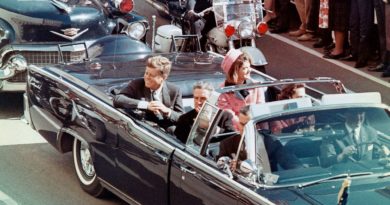Why JFK’s assassination remains a mystery
When John F Kennedy became the fourth sitting US president to be assassinated, at the hands of a gunman, in Texas 60 years ago, the country was left stunned and heartbroken.
The handsome and charismatic New Englander was shot dead in Dallas, Texas, on 22 November 1963, joining an infamous list that includes Abraham Lincoln, James Garfield and William McKinley.
Lincoln was shot in April 1865 by actor John Wilkes Booth at Ford’s Theater in Washington DC, five days after the surrender of Confederate General Robert E Lee, in an attempt to disrupt the Union and save the Confederacy. Garfield was shot in July 1881 by Charles Guiteau at a Washington DC train station, after the president refused to appoint him to a diplomatic post. Garfield died from his injuries several months later in September 1881.
McKinley was shot twice in the chest by anarchist Leon Czolgosz in Buffalo in 1901 with his attacker claiming the president was the head of a corrupt government. He died of a gangrene infection weeks later.
But the motivation for the killing of JFK, which the FBI and the Warren Commission concluded was carried out by lone assassin Lee Harvey Oswald, has always remained unclear sparking a debate that has raged for decades.
Here is what we know about the slaying of President John F Kennedy.
Why was JFK in Texas?
President Kennedy and first lady Jacqueline Kennedy had travelled to Texas as part of a campaign to unify the Democratic Party and kick off his 1964 re-election bid.
The couple spent 21 November in San Antonio, Houston and Fort Worth, flying to Dallas Love Field on Air Force One the next day.
Kennedy speaking at a press conference in August 1963
The president and first lady were collected by a convertible Lincoln Continental that would take them, along with Texas Governor John Connally, through the streets of downtown Dallas on his way to give a speech at the Trade Mart at 12.30pm.
Gunshots ring out
As the limousine pulled into Dealey Plaza, Texas’s first lady Nellie Connally turned to Kennedy and remarked on the size of the crowds, saying “Mr President, you can’t say Dallas doesn’t love you.”
In what were to be among his final words, the president replied, “No, you certainly can’t.”
JFK was looking ahead to his re-election bid in 1964
As the car passed the Texas Book Depository three shots rang out.
“It appears as though something has happened on the motorcade route, I repeat, something has happened on the motorcade route,” the radio broadcast stated.
The official version of what happened is that Kennedy was hit by two bullets from above and behind, one in the back of the neck, exiting through his throat before hitting Gov Connally, who was seriously wounded but survived the attack. The other bullet struck the president in the head.
The former Texas School Book Depository, now the Dallas County Administration Building, from were Lee Harvey Oswald is believed to have fired the fatal shots
Secret Service agent Clint Hill jumped on top of the limo and covered the first lady and the president. The motorcade then rushed to Parkland Hospital. Thirty minutes later the president was dead.
“President Kennedy died at 1pm central standard time,” TV news anchor Walter Cronkite said on air.
Kennedy’s vice president Lyndon Johnson is sworn in as the 36th President of the United States of America on board the presdential plane after Kennedy was pronounced dead
Following the killing, Lyndon Baines Johnson was sworn in as the 36th President of the United States of America on board Air Force One, with Jackie Kennedy standing next to him.
The arrest of Lee Harvey Oswald
Former Marine Lee Harvey Oswald, who had spent time in the Soviet Union, was arrested for the murder in a movie theatre less than an hour after the shooting after also killing Dallas police officer JD Tippit.
Assassination suspect Lee Harvey Oswald during a press conference after his arrest in Dallas – shortly before he too was shot dead
Two days later, as Oswald was moved through the basement of the Dallas Police Department headquarters live on television, he was shot and killed by local nightclub owner Jack Ruby.
Ruby was convicted of killing Oswald and sentenced to death but he appealed and died of cancer in 1967, before the retrial could take place.
FBI and Warren Commission
Following the Kennedy assassination the FBI carried out some 25,000 interviews and chased down thousands of leads, before concluding that Oswald acted alone.
The Warren Commission, set up by President Johnson to investigate the killing, spent a year probing the assassination and in its 889-page final report also concluded that Oswald had acted alone.
The report confirmed that there was “no evidence” that Oswald or Ruby were part of a domestic conspiracy to kill Kennedy, or that a foreign government had planned and carried out the attack.
It did note that Oswald had travelled to the Soviet Union in 1959, unsuccessfully applied for Soviet citizenship, and lived there until 1962. The report also stated that Oswald, a Marxist, had visited the Russian and Cuban embassies in Mexico City in September 1963, months before the shooting.
Conspiracy theorists have questioned the reason for Oswald’s visit to the embassies and whether or not he had contact with intelligence officials there.
However, the report ultimately did not give a conclusive motive for why Oswald had shot and killed Kennedy.
“The explanation of Oswald’s motive for killing President Kennedy was buried with him,” TIME wrote in 1964.
Conspiracies and Zapruder film
Debate and conspiracy theories have raged about the assassination over the last six decades, with thousands of books, movies, TV shows and podcasts dedicated to what happened and the mysteries that may remain.
According to a Gallup poll earlier this month a majority of Americans believe that Oswald did not act alone on 22 November 2023 and that others were involved in a plot to kill Kennedy.
The poll found that 65 per cent of US adults think Oswald worked with others to eliminate Kennedy, while 29 per cent believe he was solely responsible.
Gallup first asked Americans the same question immediately after the killing and found that 52 per cent of people believed there was “some group or element” other than Oswald involved. It found that 29 per cent believed he acted alone, while 19 per cent were unsure.
A Carcano Model 91/38 rifle is seen near where Oswald ditched his 50 years earlier, at the Sixth Floor Museum, formerly the site of the Texas School Book Depository
One reason why conspiracy theories in the case have remained consistent could be that the government has never released all its files. It was supposed to have been completed by 2017 but that date has been pushed back during both the Trump and Biden administrations.
The Warren Commission did not rely on X-rays of Kennedy or photos of the autopsy, saying that publication of that material would be an invasion of the Kennedy family’s privacy.
The National Archives report on the assassination states that “the secrecy that surrounded the autopsy proceedings, therefore, has led to considerable skepticism towards the Commission’s findings.”
Adding to that sense of doubt is a film of the assassination taken by amateur photographer Abraham Zapruder. In his video, Kennedy’s head appears to be thrown backwards, suggesting that a bullet hit the front of his head. Conspiracy theorists have claimed that the bullet could have been fired by a second gunman positioned on a grassy knoll nearby.
Two other government panels, a team of forensic pathologists in 1968 and the Commission on CIA Activities Within the United States in 1975, both agreed that Kennedy was struck by two bullets from behind.
Meanwhile, 2024 presidential hopeful Robert Kennedy Jr – a nephew of JFK and son of Robert F Kennedy, who was himself assassinated in Los Angeles in 1968 while running for president – backs a conspiracy theory that the CIA was responsible for the killing of his uncle, calling the evidence “overwhelming.”
Robert F Kennedy Jr belives the CIA was involved in his uncle’s murder
“There is overwhelming evidence that the CIA was involved in his murder,” Mr Kennedy said in a May interview with John Catsimatidis on New York City radio station WABC 770. “I think it’s beyond a reasonable doubt at this point.”
Mr Kennedy went on to suggest that the killing was carried out because the president had refused to commit US troops to Vietnam.
“When my uncle was president, he was surrounded by a military-industrial complex and intelligence apparatus that was constantly trying to get him to go to war in Laos, Vietnam, etc,” Mr Kennedy said. “He refused. He said that the job of the American presidency is to keep the nation out of war.”
The House Select Committee on Assassinations said in a 1979 report that it was probable that two gunmen fired at Kennedy and that he was likely assassinated because of a conspiracy. However, it could not identify the second gunman or give any real details on what the conspiracy was.
John McCone, who was CIA director when Kennedy was assassinated, testified to the committee that despite conspiracy theories Oswald was not a CIA agent and that the agency had never communicated with him.
But of course, with Oswald’s assassination by Ruby, he could never be put on trial or tell a jury exactly why he had carried out the killing.
Secret Service agent reveals new detail in book
On 22 November 1963, Paul Landis was a 28-year-old Secret Service agent riding in the car directly behind the president’s limousine. He was assigned to protect the first lady.
In a new book Mr Landis, now 88, says that he found an intact bullet next to the first lady, which he collected and left on the president’s stretcher but never told the Warren Commission about because of the trauma he suffered. He does not believe there was a second shooter.
“I reached over and took her by the shoulders and tried to help her up, but she was leaning over the president’s head, covering his head,” he told Pittsburgh’s Action News in an interview to mark the 60th anniversary.
He accompanied Kennedy to the hospital, where he remembered “everybody was pushing and shoving and screaming.”
And he recalled: “I got wedged up against the exam table where they had removed the president’s body.”
The front page of the New York American Journal announcing the shock news
While the new description of the bullet is a small detail, Mr Landis’s account differs from the official account of the shooting, which says that the bullet was found on Gov Connally’s stretcher. The new claim challenges the idea of a “magic bullet” hitting Kennedy, then hitting Connally and adding another layer of mystery to the events.
Mr Landis thinks that the bullet may have been undercharged and hit Kennedy in the back before popping out and coming to rest in the limousine, where he found it.
His new book, The Final Witness, was published by Chicago Review Press last month.
“There’s no goal at this point,” he said in an interview before its publication. “I just think it had been long enough that I needed to tell my story.”
Mr Landis’s new account has drawn scepticism from others who were there that day, including his colleague Clint Hill.
“If he checked all the evidence, statements, things that happened, they don’t line up,” Mr Hill told NBC News. “It doesn’t make any sense to me that he’s trying to put it on the president’s gurney.”
This article has been archived for your research. The original version from The Independent can be found here.



